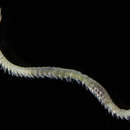en
names in breadcrumbs


Scolelepis squamata ist ein mariner Ringelwurm aus der Familie der Spionidae innerhalb der Klasse der Vielborster (Polychaeten), der in Meeren weltweit verbreitet ist.
Scolelepis squamata hat im ausgewachsenen Alter einen bis etwa 14 cm langen, vergleichsweise schlanken, bläulich-grünen Körper mit über 200 Segmenten. Das schmal kegelförmige, an beiden Enden spitz zulaufende Prostomium trägt 4 trapezartig angeordnete Augen, aber keine Antennen. An seinem Hinterende sitzt eine dreieckige Karunkel, die bis zum 2. oder 2. borstentragenden Segment reicht. 2 lange Palpen sind vorhanden.
Die Lappen hinter den Borsten der Notopodien sind am ersten Segment klein und oval, an den folgenden, kiementragenden Segmenten lang, lanzettlich und auf mehr als ihrer halben Länge mit den Kiemen verschmolzen, an den hinteren Segmenten kürzer und fast ganz getrennt. Die Lappen hinter den Borsten der Neuropodien sind an den vorderen Segmenten kurz und gerundet, vom 18. bis 20. Segment an schwach zweilappig. Kiemen sitzen an allen Segmenten außer dem ersten und den letzten sieben Segmenten. Sie haben die Gestalt von Cirren und sind länger als die Lappen hinter den Borsten der Notopodien. Alle Parapodien haben kapillarförmige Borsten, die Notopodien ab dem 26. bis zum 40. Segment und die Notopodien an dem 60. bis 65. Segment auch Haken mit Hauben, meist zweizähnig, manchmal einzähnig oder mit zwei kleinen akzessorischen Zähnchen. Das Pygidium hat einen einzelnen Lappen.
Scolelepis squamata ist wahrscheinlich in Meeren weltweit mit Ausnahme der Arktis und der Antarktis verbreitet, so auch in der Nordsee bis zum Öresund, beiderseits des Atlantischen Ozeans, im Mittelmeer, Karibischen Meer und Golf von Mexiko.[1] Der Polychaet lebt an Sandstränden in der Gezeitenzone und darunter in reinem oder leicht schlammigen Sand oder Schill, wobei er auch im Brackwasser von Ästuaren zu finden ist. Im Sediment gräbt er sich senkrechte Wohngänge, die er mit Schleim auskleidet. Er kann aber auch mit schlangenartigen Bewegungen schwimmen.
Mit seinen beiden Palpen sammelt Streblospio benedicti Nahrungspartikel aus Detritus und Kleinstlebewesen von der Substratoberfläche ein und befördert sie durch Zusammenziehen der Palpen, denen Wimpern fehlen, zum Mund. Gibt es eine ausreichende Wasserströmung, vermag der Polychaet alternativ auch als Filtrierer Detritus aus der Wassersäule einzusammeln, wozu die Palpen schraubenförmig aufgedreht werden. Untersuchungen des Darminhalts zeigen, dass die Nahrungspartikel aus Sedimentkörnchen, Kotballen anderer Tiere und einer Reihe von Einzellern und kleinen Larven bestehen.[2]
Scolelepis squamata ist getrenntgeschlechtlich. An der Südküste Großbritanniens paaren sich Männchen und Weibchen, indem sie ihre Gameten von Mai bis Juli ins frei Meerwasser entlassen, während sie dies an der Küste Brasiliens das ganze Jahr über tun. Die Befruchtung findet im freien Wasser statt, und aus den Zygoten entwickeln sich frei schwimmende, als Zooplankton lebende und Phytoplankton fressende Larven, die nach etwa 5 Wochen auf den Meeresboden niedersinken und zu kriechenden Würmern metamorphosieren. Der Ringelwurm ist kurzlebig und hat eine hohe Reproduktionsrate.
Scolelepis squamata ist ein mariner Ringelwurm aus der Familie der Spionidae innerhalb der Klasse der Vielborster (Polychaeten), der in Meeren weltweit verbreitet ist.
Scolelepis squamata is a species of polychaete worm in the family Spionidae. It occurs on the lower shore of coasts on either side of the Atlantic Ocean.
Scolelepis squamata is a slender, bluish-green worm with a maximum length of about 14 cm (5.5 in) and over two hundred segments when fully grown. The prostomium (head) is diamond-shaped and has four eyes, arranged in a trapezoid fashion, two long slender palps, and no central antenna. Each segment has a pair of parapodia with chaeta (bristles). The dorsal lobes of the parapodia are long and thin and are fused to the gills for half their length. The ventral lobes are rounded and short, and slightly bilobed from segment 20 onwards. There are gills (red) on all segments except segment 2 and the last seven body segments.[2]
Scolelepis squamata is found on both sides of the Atlantic Ocean, the Mediterranean Sea, the Caribbean Sea and the Gulf of Mexico. It digs a burrow in the sediment in the lower parts of the shore and the shallow sublittoral. Typically it chooses sandy beaches in the intertidal zone and sandy and silty sediments in subtidal flats. It tolerates low salinity levels and is often found in estuaries.[3]
Scolelepis squamata lives in a mucous reinforced, vertical burrow in the sediment. It uses the long palps to feed on organic particles on the nearby seabed. The palps do not have a ciliated groove, so the particles are brought to the pharynx by a contraction of the whole palp. If there is a current, each palp can be coiled up in a helix, and the animal can feed entirely on suspended particles. Examination of the contents of the gut showed sediment particles, faecal pellets of other animals and a variety of embryos, larvae and juvenile prey.[4]
On the south coast of Britain, this worm breeds between March and July; sperm and eggs are released into the sea where fertilisation takes place, and the larvae are planktonic for about five weeks before settling on the seabed and developing into juvenile worms.[5] In Brazil, it is one of the commonest species of worm on some intertidal beaches. Here it breeds all year round, with peak recruitment of juveniles in April and October. This worm has a short life-span and seems to have adopted a strategy of high growth rate, high reproductive effort and opportunistic behaviour.[6]
Scolelepis squamata is a species of polychaete worm in the family Spionidae. It occurs on the lower shore of coasts on either side of the Atlantic Ocean.
Scolelepis (Scolelepis) squamata is een borstelworm uit de familie Spionidae. Het lichaam van de worm bestaat uit een kop, een cilindrisch, gesegmenteerd lichaam en een staartstukje. De kop bestaat uit een prostomium (gedeelte voor de mondopening) en een peristomium (gedeelte rond de mond) en draagt gepaarde aanhangsels (palpen, antennen en cirri).
Scolelepis (Scolelepis) squamata werd in 1806 voor het eerst wetenschappelijk beschreven door O.F. Muller.
Bronnen, noten en/of referenties